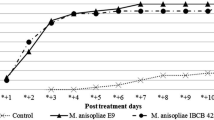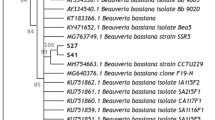Abstract
Rhipicephalus microplus (Canestrini) is an ectoparasite accountable for great economic losses. The use of entomopathogenic fungi to control arthropods has shown promising responses. The present study evaluated the virulence of Isaria farinosa (Holmsk.) Fr., Isaria fumosorosea (Wize) Brown and Smith, and Purpureocillium lilacinum (=Paecilomyces lilacinus) (Thom.) Samson to engorged females, eggs, and larvae of R. microplus. There were four treatment groups (105, 106, 107, and 108 conidia ml−1) and the control group (water and Tween 80, 0.1 % v/v). The treatment was based on immersion of the specimen in 1 ml of the suspension or control solution. The study observed changes in egg viability and larval mortality after treatment. The results showed that I. farinosa, P. lilacinum, and I. fumosorosea caused alterations in the biological parameters of R. microplus ticks. I. fumosorosea presented the greatest potential to control R. microplus engorged females in vitro, causing a 49 % decrease in nutritional index. All fungal isolates presented significant reduction in the egg production index. I. farinosa reduced the hatching percentage if the eggs were treated with the two highest conidial concentrations. All conidial concentrations of I. fumosorosea were able to reduce the hatching percentage significantly. All tested isolates showed pathogenicity toward unfed R. microplus larvae. As far as we know, this is the first study reporting the effect in vitro of I. farinosa, I. fumosorosea, and P. lilacinum to different developmental stages of R. microplus ticks.



Similar content being viewed by others
References
Alves SB (1998) Controle microbiano de insetos, 2nd edn. FEALQ, Piracicaba
Angelo IC, Fernandes EK, Bahiense TC, Perinotto WMS, Moraes APR, Terra ALM, Bittencourt VREP (2010) Efficiency of Lecanicillium lecanii to control the tick Rhipicephalus microplus. Vet Parasitol 172:317–322
Barros TAM, Evans DE (1989) Ação de gramíneas forrageiras em larvas infectantes do carrapato dos bovinos Boophilus microplus. Pesquisa Vet Brasil 9:17–21
Bennett GF (1974) Ovoposition of Boophilus microplus (CANESTRINI) (ACARIDA: IXODIDAE) I. Influence of tick size on egg production. Acarologia 16:52–61
Bittencourt VREP, Peralva SLFS, Souza EJ, Mascarenhas AG, Alves SB (1997) Ação de dois isolados do fungo entomogênico Beauveria bassiana sobre algumas características biológicas de fêmeas ingurgitadas de Boophilus microplus em laboratório. Rev Univ Rural Ser Cienc Vida 19:65–71
Bowman AS, Nuttall P (2008) Ticks—biology, disease and control. Cambridge University Press, UK
Chandler D, Davidson G, Pell JK, Ball BV, Shaw K, Sunderland KD (2000) Fungal biocontrol of acari. Biocontrol Sci Techn 10:357–384
Davey RB, Garza JG, Thompson GD, Drummond RO (1980) Ovipositional biology of the southern cattle tick, Boophilus microplus (Acari: Ixodidae) in the laboratory. J Med Entomol 17:117–121
Drummond RO, Gladney WJ, Whetstone TM, Ernst SE (1971) Laboratory testing of insecticides for control of the winter tick. J Econ Entomol 64:686–688
Fernandes EKK, Bittencourt VREP (2008) Entomopathogenic fungi against South American tick species. Exp Appl Acarol 46:71–93
Fernandes EKK, Costa GL, Moraes AML, Zahner V, Bittencourt VREP (2006) Study on morphology, pathogenicity, and genetic variability of Beauveria bassiana isolates obtained from Boophilus microplus tick. Parasitol Res 98:324–332
Fernandes EKK, Moraes AML, Pacheco RS, Rangel DEN, Miller MP, Bittencourt VREP, Roberts DW (2009) Genetic diversity among Brazilian isolates of Beauveria bassiana: comparisons with non-Brazilian isolates and other Beauveria species. J Appl Microbiol 107:760–774
Fernandes EKK, Keyser CA, Chong JP, Rangel DEN, Miller MP, Roberts DW (2010) Characterization of Metarhizium species and varieties based on molecular analysis, heat tolerance and cold activity. J Appl Microbiol 108:115–128
Finney DS (1971) Probit analysis, 3rd edn. Cambridge University Press, Cambridge
Gindin G, Samish M, Alekseev E, Glazer I (2001) The susceptibility of Boophilus annulatus (Ixodidae) ticks to entomopathogenic fungi. Biocontrol Sci Techn 11:111–118
Gindin G, Samish M, Zangi G, Mishoutchenko A, Glazer I (2002) The susceptibility of different species and stages of ticks to entomopathogenic fungi. Exp Appl Acarol 28:283–288
Grisi L, Massard CL, Borja GEM, Pereira JB (2002) Impacto econômico das principais ectoparasitoses em bovinos no Brasil. Hora Vet 21:23–28
Hawksworth DL (1977) Micologist's handbook, 2nd edn. CAB Press, Kew
Kaaya GP, Hassan S (2000) Entomogenous fungi as promising biopesticides for tick control. Exp Appl Acarol 24:913–926
Lomer CJ, Bateman RP, Johnson DL, Langewald J, Thomas M (2001) Biological control of locusts and grasshoppers. Annu Rev Entomol 46:667–702
Luz C, Tigano MS, Silva IG, Cordeiro CMT, Aljanabi SM (1998) Selection of Beauveria bassiana and Metarhizium anisopliae isolates to control Triatoma infestans. Mem Inst Oswaldo Cruz 93:839–846
Monteiro SG, Bahiense TC, Bittencourt VREP (2003) Ação do fungo Beauveria bassiana (Balsamo) Vuillemin, 1912 sobre a fase parasitária do carrapato Anocentor nitens (Neumann, 1897) Schulze, 1937 (Acari: Ixodidae). Cienc Rural 33:559–563
Pirali-Kheirabadi K, Haddadzadeh H, Razzaghi-Abyaneh M, Bokaie S, Zare R, Ghazavi M, Shams-Ghahfarokhi M (2007) Biological control of Rhipicephalus (Boophilus) annulatus by different strains of Metarhizium anisopliae, Beauveria bassiana and Lecanicillium psalliotae fungi. Parasitol Res 100:1297–1302
Polar P, Kairo MTK, Peterkin D, Moore D, Pegram R, John S (2005) Assessment of fungal isolates for development of a myco-acaricide for cattle tick control. Vector-Borne Zoonot 5:276–284
Reis RCS, Melo DR, Souza EJ, Bittencourt VREP (2001) Ação in vitro dos fungos Beauveria bassiana (Bals.) Vuill e Metarhizium anisopliae (Metsch.) Sorok sobre ninfas e adultos de Amblyomma cajennense (Fabricius, 1787) (Acari: Ixodidae). Arq Bras Med Vet Zoo 53:544–547
Ren Q, Sun M, Guan G, Li Y, Liu Z, Liu A, Ma M, Niu Q, Liu J, Yin H, Luo J (2011) Biological control of engorged female Haemaphysalis qinghaiensis (Acari: Ixodidae) ticks with different Chinese isolates of Beauveria bassiana. Parasitol Res 109:1059–1064
Rivalier E, Seydel S (1932) Nouveau procede de culture sur lames gélosés appliqué a l’étude microscopique de champignos deteignes. Ann Parasitol 10:444–452
Samish M, Rehacek J (1999) Pathogens and predators of ticks and their potential in biological control. Annu Rev Entomol 44:159–182
Samish M, Gindin G, Alekseev E, Glazer I (2001) Pathogenicity of entomopathogenic fungi to different developmental stages of Rhipicephalus sanguineus (Acari: Ixodidae). J Parasitol 87:1355–1359
Samish M, Ginsberg H, Glazer I (2004) Biological control of ticks. Parasitology 129:389–403
Sampaio IBM (2002) Estatística Aplicada à Experimentação Animal, 2nd edn. FEPMVZ, Belo Horizonte
Samson RA (1974) Paecilomyces and some allied Hyphomycetes. Stud Mycol 6:120
Acknowledgments
We are grateful to the National Center for Genetic Resources (CENARGEN)/Brazilian Agricultural Research Corporation (EMBRAPA) for providing the fungal isolate used in this study. This research was supported by grants from the National Council for Scientific and Technological Development (CNPq) and the Rio de Janeiro State Research Foundation (FAPERJ). We also thank the Office to Improve University Research (CAPES) for providing the M.Sc. and Ph.D. scholarship to I.C.A., É.K.K. F., T.C.B., W.M.S.P., P.S.G., and A.P.R.M. V.R.E.P. Bittencourt is CNPq researcher (1B).
Author information
Authors and Affiliations
Corresponding author
Rights and permissions
About this article
Cite this article
Angelo, I.C., Fernandes, É.K.K., Bahiense, T.C. et al. Virulence of Isaria sp. and Purpureocillium lilacinum to Rhipicephalus microplus tick under laboratory conditions. Parasitol Res 111, 1473–1480 (2012). https://doi.org/10.1007/s00436-012-2982-y
Received:
Accepted:
Published:
Issue Date:
DOI: https://doi.org/10.1007/s00436-012-2982-y




